Saturday night I got a chance to shoot the USF Bulls vs. Western Kentucky football game from the sidelines with my buddy sports photographer Andy Gregory. Here are a few of shots from the game. (I got the image above just as the team had gathered in the tunnel to enter the field through an air curtain of C02)
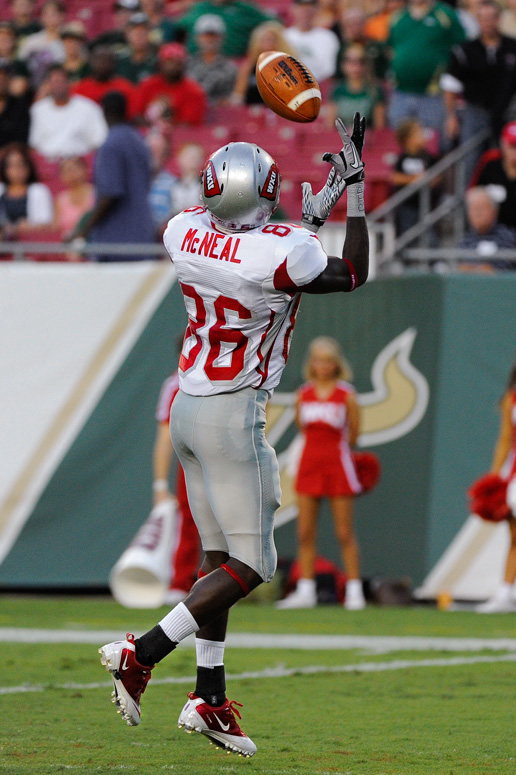
Lens Length vs. ISO & Noise Issues
When I shot the LSU – North Carolina game a few weeks ago, I took my new 300mm f/2.8 lens, and absolutely totally loved it, but you do have to hustle a little more up and down the sidelines to stay close enough to the action. Saturday night, I used my 200-400mm f/4, which worked out pretty darn well because of the extra 100mm reach, but I’m not sure it’s quite as magical as the 300mm f/2.8, with its super-shallow depth of field and the ability to shoot at a lower ISO (plus, losing that one extra stop at f/4 means I have to shoot at least 3,200 ISO the whole night).

(Photo above of yours truly in the tunnel, decked out in knee pads, by Andy Gregory. This was the only in-focus shot Andy took all night. Sorry Andy—I couldn’t help myself)
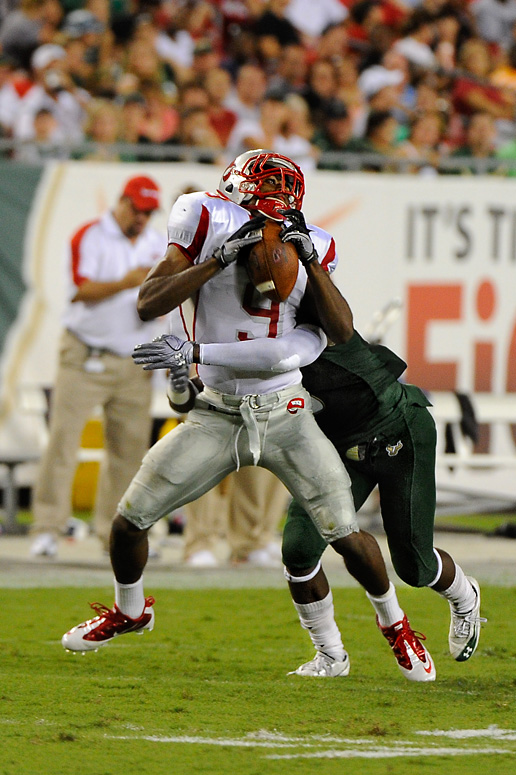
So, it’s a trade off. I can shoot a 400mm, and get in nice and tight, but it’ll be a little noisier (though I borrowed RC’s D3s to help keep the noise at a minimum). Or I can shoot at 300mm, where I get less noise and sharper photos (because I can shoot at a much lower ISO), but then I’m not in as tight. So, what’s the ideal lens for football? Probably the one I tried to rent from LensProToGo.com, the 400mm f/2.8 but I was too late—it was already out on rental.
The Lens bottomline
Now that I’ve recently shot with both lenses, if I was shooting another game, like say…tonight’s Bears/Packers Monday Night Football game (Go Bears!), I’d probably take my 300mm f/2.8, for the better depth of field, lower ISO capabilities, and sharper images with probably better color rendition (thanks to the lower ISO as well).
Interesting Side Note
I haven’t shot a college football or NFL night game where there wasn’t a photo credentialed photographer on the sidelines shooting a Canon Rebel, or a Nikon D90 (or equivalent) with a kit zoom lens no longer than 105mm at f/5.6. The noise has got to be brutal for night games or games held in dome stadiums.
Camera Stats:
I used two bodies and two lenses. On the D3s, I used the 200-400mm f/4, at ISO 3,200 at f/4 all night. The second body was D3 with a 70-200mm f/2.8 lens, which I shot at 2,000 ISO at f/2.8 all night. Since it’s a sports shoot (and my buddy Paul Abell wasn’t there to shame me into shooting in Raw), I shot in JPEG Fine mode on both cameras.
(Above: I caught a few of the players heading to the USF locker room right after the game. Where I was positioned, there was about a 20 ft. area that was lit by the stadium lights, and then past that it went into shadows. I caught this shot just as the player was moving into the shadow area. I had to brighten his face just a little, and I converted it to black and white to add more drama).
Post Processing
Very little done to these (except the photo below)—no color correction (all shot using Auto White Balance), and just added some contrast here and there and just regular Unsharp Mask sharpening. You have to be careful sharpening images at high ISO, because any noise that’s already in the photos gets amplified. I didn’t use any noise reduction in post either.
Click on it
To really appreciate the shot above, where the bench is calling for the ref to throw a flag for a personal foul, you have to click on it to see the larger contrast enhanced version.
Above: probably my favorite shot from the night—just after USF’s win, #12 high-fives fans as the team leaves the field.
My thanks to the USF Bulls Football organization for having me shoot the game, and to Andy Gregory for putting up with my constant harassment throughout the night (he’s a friend of Matt’s, so he’s used to it).



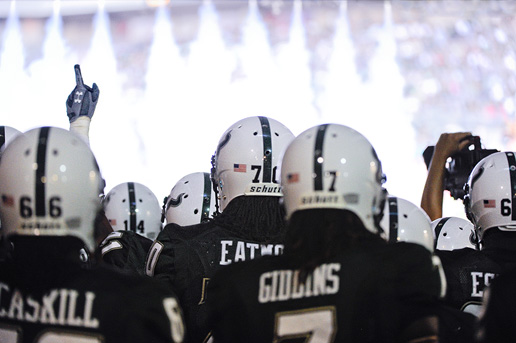
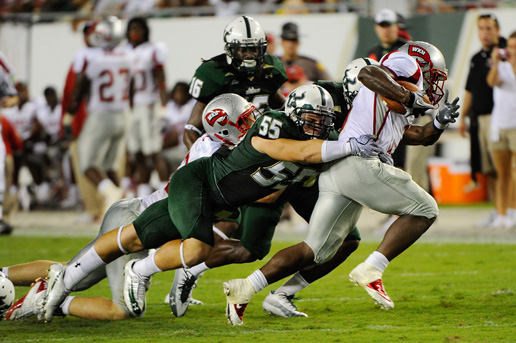
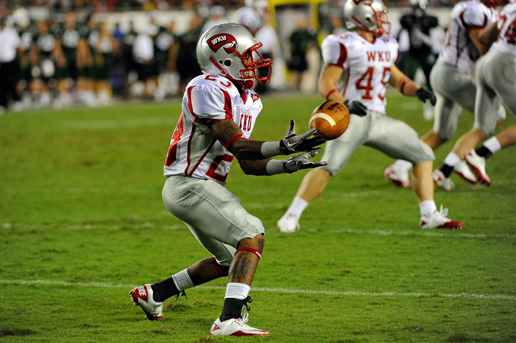
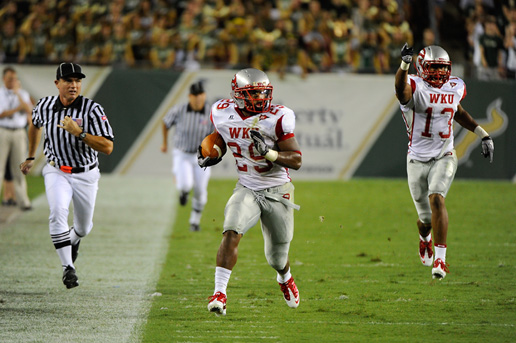
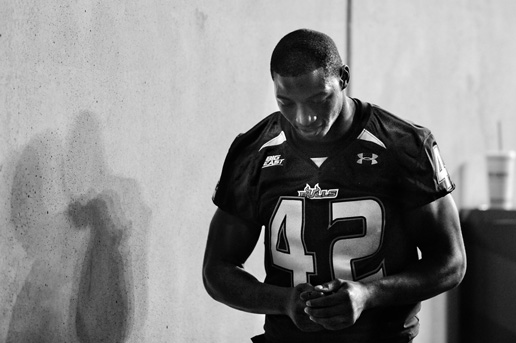
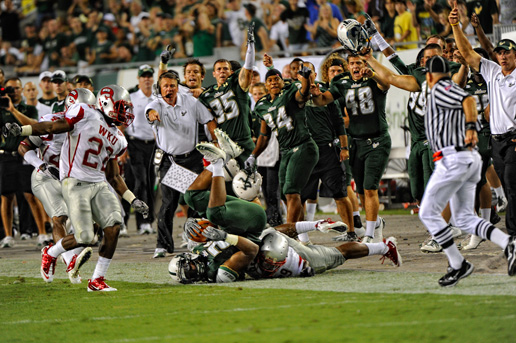
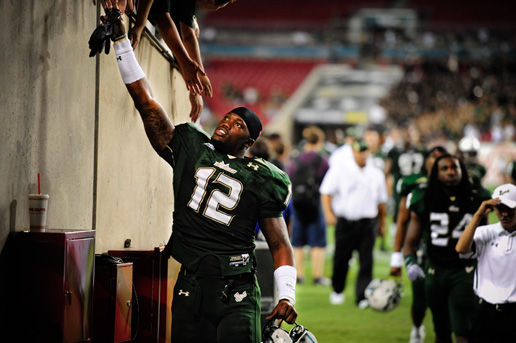
Scott,
I can’t thank you enough for including the gory (geeky :-) ) details for those of us learning.
How many shots about did you get during the game to get these 9 stunning images?
Cute dig at Andy BTW
Hi NL:
I took right around 1,100 shots, which most pros would tell is WAY too few. I shoot every play, but of course, a lot of plays nothing happens, or the running back gets buried in a pile and you not only don’t see the ball, but you don’t see the running back at all. Also, so action happens so far away from where you’re shooting, the players look like little ants, so there are some that just get away. This happens a lot when you’re set up in a corner of the end zone, and they throw a fade to the opposite corner, or just a run to that side. There are officials and video crew standing directly in your path, and all you get is a burst of 30+ blurry ref and video crew shirts. This happens at the USF game, and a female photographer shooting on assignment there was just as pissed as she could be, but that’s just how it goes. The action doesn’t always happen right in front of you—it’s a big field.
Also, I just checked—out of that 1,100 or so shots, I had 79 that I marked as “Picks” (so 79 keepers).
-Scott
Scott, I get to shoot the Shrine Bowl each year and we post most of our photos for families to buy to benefit the Shrine Hospitals. Out of the 2000+ photos, only a few were “real good”. I find keeping focus on right subject is hard for me.
Scott, amazing shots as always and I can’t believe the noise levels in these shots or should I say lack of noise. I have to ask what focusing technique do you use when shooting football or other sports ? I saw a presentation the other day by one of the SI guys and he said he tracks manually and I thought that was gutsy. I come from the old school as well but going to manual focus sounds challenging for these types of events.
I think I attended the same presentation (by Bill Frakes, right? Great presentation!). Unfortunately, I’m not at the point where I could switch to Manual focus and get, well…anything in focus, so I shoot Auto Focus the whole time, but I do switch the Focus lock time from normal to short, or I turn it off altogether, so it doesn’t pause for a moment before it focuses. I also shoot in Continuous focus mode, and that helps as well (I need all the help I can get). :)
-Scott
“Interesting Side Note
I haven’t shot a college football or NFL night game where there wasn’t a photo credentialed photographer on the sidelines shooting a Canon Rebel, or a Nikon D90 (or equivalent) with a kit zoom lens no longer than 105mm at f/5.6. The noise has got to be brutal, especially for night games.”
This is very interesting – I’ve actually had wedding photogs tell me that I have more lights than many in that “club” have. While the noise is definitely an issue in sports photography, the software has likely kept many “in the game”. From the outside looking in though, it just goes to show you (from the rank amateur/enthusiast perspective) that when it comes down to it, the gear does not make the photographer, the photographer makes his or her own shots.
The only other thing here is to agree with the “Go Bears” – they’re the push I need in my fantasy pool to maintain my 1st place ranking tomorrow! :)
“I haven’t shot a college football or NFL night game where there wasn’t a photo credentialed photographer on the sidelines shooting a Canon Rebel, or a Nikon D90 (or equivalent) with a kit zoom lens no longer than 105mm at f/5.6. The noise has got to be brutal, especially for night game”
Interesting to read. I wonder why those photographers are not ruled out to enter the game by their fellow collegues as it is a sort of same case as your story in the “a great day for sports photography” scandal!
Nice shots. Always good to see you in action :)
The first photo is a real nice one for me specially with that 1 hand up :)
Last 2 shots are great as well. But did you get one without a blur for the second last appeal shot.
Could you share for what shots did you use the the second body – D3 with a 70-200mm f/2.8 lens.
Thanks in advance.
Hi Girish:
I use that shorter lens when the ball is inside the 20 yard line. The 300mm can get too tight if they’re really close to where I’m shooting from. During the game, you often don’t have time to switch lenses, so you keep a second body with the shorter lens already on it. Some guys have a wide angle on their second lens, and some have a 50mm on it, but I see a lot of both Canon and Nikon guys out there with a 70-200mm on their second body (and they nearly all have a second body). :)
-Scott
Thanks for the info.
Does one get enough time to change bodies in a faster paced game like soccer. How does one handle with say a 300mm lens if the action comes very close.
Sorry about the noob like questions, would be only couple of that I would lay my hands on a Dslr. But keen to learn that’s all :)
Fantastic shoot, Scott. What I particularly like with all your shoots is that you shoot like a photojournalist, seeing the entire story, from the small details to the big picture. When you do these game shoots, are you shooting for the team, Southcreek Global or for yourself?
Have a great week!
Trev J.
Scott I’m using your ISO Auto setup for shooting sports from one of your many books, but I’m a little confused. How do you keep your ISO numbers so low 3200? I shot at a college stadium on Friday night with a D3s & 70-200 f2.8 w/1.4 tele so f/4 all night @1/1000 sec, but I didn’t get a single shot under 10000? Is there something I’m missing?
Thanks in advance
MisterB
MisterB,
I believe in the menu – you can set your min and max ISO levels.
T
Thanks Troy — I actually did set my ISO to max, because I didn’t think they’d be that high. My concern is that my photos would have been much darker than they were if I had shot at 3200 ISO.
Thanks again, Mike
Your recent football photos posts have got me looking into shooting American Football games here in the UK. I know it’s a much smaller scale but I’d love to give it a go.
Hi Scott, I appreciate the time and effort you take to share your knowledge and insight through your website, Facebook page, and of course your published books. Do you have any experience shooting a D700? How do you think the shots you took at the game would have compared?
Cool pics, I myself have never felt very confident photographing sports. I am never quite sure what is the best way to focus.
I did however volunteer to photograph a marathon this past Saturday. I uploaded them from my memory card late last night, so I guess today I will know if I did a good job or not.
Terrific shots, Scott. I like the shot of the WKU player running down the sideline with one of the officials beside him (man, those officials have to be in great shape!), and the last one of the player “high fiving” the fans as he leaves the field. I usually see that kind of shot with the player’s back to the camera.
Any pro football game shoots on the docket? There must be a Bucs game that you can get into!
–John
Hi John:
Thanks so much for the kind words. :-)
As for NFL games, I do have a few lined up. In fact, one’s coming up very soon. :)
-Scott
Being a Patriots fan myself, I hope it’s the Pats/Miami game on Monday night next week! I can only dream of seeing that live! Thanks again! :)
Scott,
I see you are enjoying that new 300 (got to get me one), I love that last photo! I have noticed (as with most photogs I follow) that your shots are evolving better! I really mean that, it looks like you are looking beyond the ball. That game goes by faster when your shooting it, right? I would love to shoot an event with ya, maybe a Nascar (I have some pull there)!
K
That would be nice if all three of us could get into a NASCAR event maybe in Daytona or Charlotte or something.
mike
Scott: Great shots! I’m so jealous.
I shot my son’s Pee-Wee football game on Friday night. I don’t know if the lights at a college stadium are brighter or what, but I couldn’t get anything close to what you got.
My setup: Canon Rebel T2i. At ISO 6400, the only way to keep the shutter speed at greater than 1/1000 was to shoot at f/1.8 or f/2.0. Since my normal 55-250mm lens is f/4.0-f/5.6, the only thing I could do was use my 50mm f/1.8. I also switched to center weighted metering due to the dark skys. Maybe I should try spot metering.
In LR 3 I had crop the photos heavily (thanks to Canon for 18 megapixels) to get close to the action. Then I also had to crank up the Noise Reduction. Even so, thing were both soft and noisy. Sharpening isn’t helping, as you said, because it adds to the noise.
I was shooting jpg as you’d advised, but I’m considering trying Raw this week to see if a) the noise reduction in LR will be better and b) if I can underexpose a little and then get a higher shutter speed with lower noise and bump the exposure in LR. Any idea if those benefits might outweight the loss of burst buffering?
Any other tips for those of us who don’t own a 300mm f/2.8 lens? I’d like to, but I don’t think I can get that past the finance committee at my house. :) I looked into renting a better lens, but with night games for at least the next 6 weeks, the cost is still too much.
I wonder if this might make for a good episode of D-Town TV?
Great question and I would love to see the reply to this. Will bookmark this page.
I’m quite certain that the lights are much better than a pee wee game, but not because it’s college. The game was played at Raymond James Stadium, home of the Tampa Bay Bucs.
Like you said though, you just have to improvise.
Mike
I have the same set-up as you however I’m shooting a T1i so my ISO range is limited to 1600. My 11 year old son shot my night football game with my equipment using a 70-200mm f4-5.6 lens, Manual mode, ISO 1600, and shutter speed 1/320, any faster and the shots were too dark. I have a 50mm f1.2 prime also but I wanted him to get in tight so we used the longer lens. The majority of the shots were dark but I fixed them in post using Aperture, good thing we shot in RAW. There were some shots afterwards that still had a lot of noise due to the amount of processing I had to do in Aperture. I hope this helped
I guess with lens selection, you have to sacrifice clarity for closeness. Great shot of the bench calling for the flag.
Excellent shots. Can you tell me what your AF Focal point selections are when you shoot moving targets like these athletes? Is there one particular focus point you prefer (like the eyes) I shoot with a 7D. Thanks! I have your Digital Photography book in my camera bag :)
Lulu,
Use AI Servo on the 7D and the most sensitive point on the 7D is the centre point (It is on all Canon cameras.) I use that one on my 1D MkIV and 7D when shooting ice hockey.
Pages 87 and 89 of the 7D manual give you your options. The cross hatch 5 points may help too. Pages 86 thru 91 will be your most helpful in the manual.
Good tip is to scan any pages you need to refer to regularly, crop and laminate them. You can highlight any bits and have a quick memory jogger. Adding those custom functions to the My Menu screen will also help change things faster.
Good luck,
Scott
Increase your Chances Scott…
http://www.borrowlenses.com/
http://www.lensrentals.com/for-nikon
Have rented from them both as well as lensprotogo & I would say same great service.
Nice job. I’ve asked this questions a few times before (with no response). When you use your monopod are you using any type of monopod head? Or, are you connecting straight to the monopod? I shot my daughter’s club cheer, and the action is very fast when they tumble. Some of the venues are starting to allow monopods. Thanks Scott for any info.
Hey Scott,
Great post as usual. I also enjoyed reading the comments. Have a great time at Soldier Field tonight. I always root for the Bears except like last week when they beat my Cowboys. :( I’m sure you have similar feelings about the Bucs. :)
See ya,
Mike
I must admit that as European I don’t get much access to American Football and also have to admit that I don’t really get it! What I do get however is the quality of your images and I REALLY love the last image and the B&W image as its about people and capturing a passion from a sporting event from a different perspective not just the action from the touch line. Very cool
Great work…thanks for sharing your comments from an insiders perspective. I’ve followed you (and own a few of your books) for quite some time and really appreciate the tips.
However, since I live near Green Bay…Go Pack!
Scott,
I have an interesting idea for a shoot the night of Oct 9 in Lakeland, FL. Email me if you would be interested to learn more.
Steve
I love the personal foul shot! I love how the USF logo is right side up on the football. very awesome. did you get any shots of the fans? And why so many WKU photos, in a USF Bulls post?
A challenge for you in your sports career.. head down to a small high school game to work some really dim light. Getting 1/250, f2.8 at iso 6400 is not out of the question, so shooting with lower spec bodies (like those generally provided at small-town papers) is particularly painful.
It would be useful to a lot of us further down the ladder to see how you would post-process in that situation to make usable prints.
Thanks for sharing your sports adventures!
Don Johnson
http://www.easttexasphoto.com
http://www.terrelltribune.com
I love the penalty one. For some reason it reminds me of a Norman Rockwell painting, because of the way you edited it. I guess the content reminds me of one of his paintings as well. Great shot, I love the players’ legs all tangled up and in the air.
Thanks for the breakdown on choosing the right lens for the situation, and the reasoning behind your choices. I’ve often found that shooting fast motion sports is a lot like surveillance photography … just not as risky (no need to pack your body armor – unless you’re trying to get through the parking lot at a Raiders game.).
Best
Jim Hoerricks
Forensic Photoshop
Thanks for the great posts – both pics and words. I have read vol 1 and 2 of your books and I had no idea from them that you were such an acccomplished sports photographer. There is really nothing in print about photographing sports like football soccer etc. Please share your thoughts and experience in this area.
Thanks
Rob
I like the last one most. The light is very nice and the fact that player12 isn’t in the very middle of the picture makes it more attractive to me. It looks a little bit like a movieposter but very very nice.
Mr. Kelby
You have talked about your sports lens preference being f/2.8 and that most pro use a 400mm lens, but this is normally on a pro body. Would it be safe to say that one could use a 300 f/2.8 on a crop body (7d or D300) with close to the same results?
Sincerely
Tom